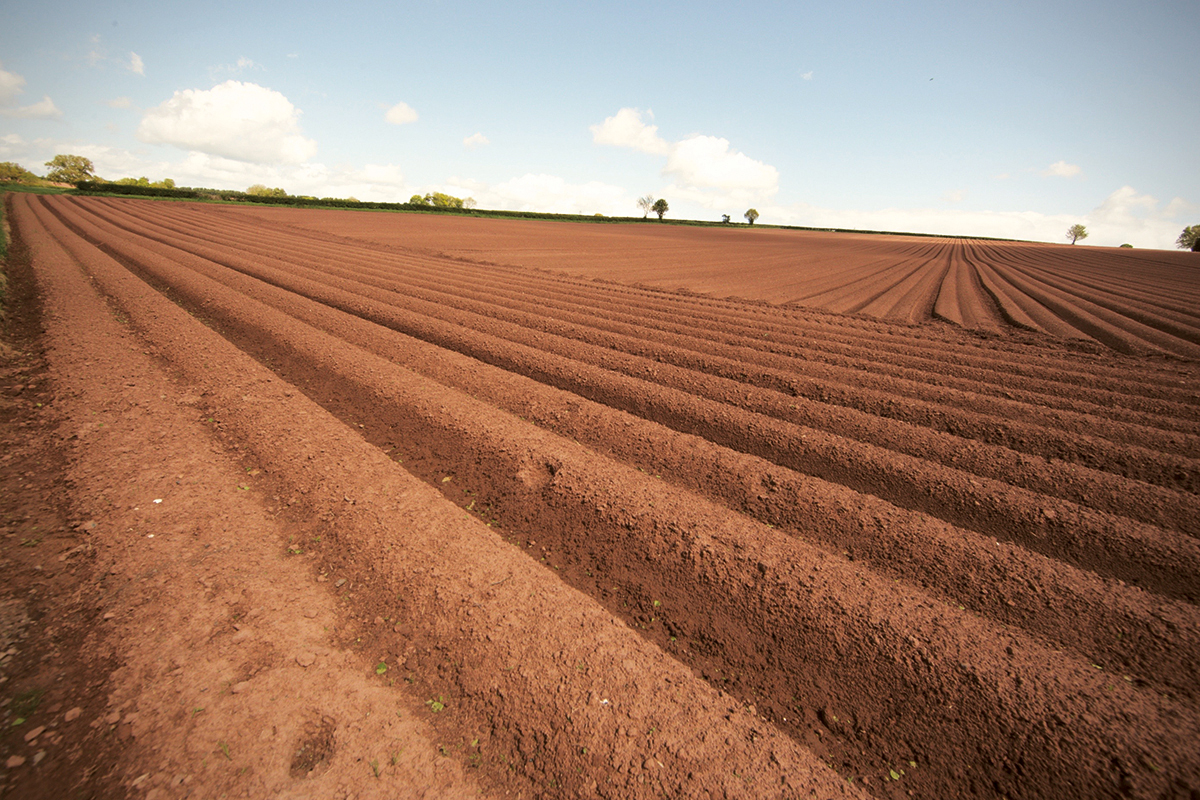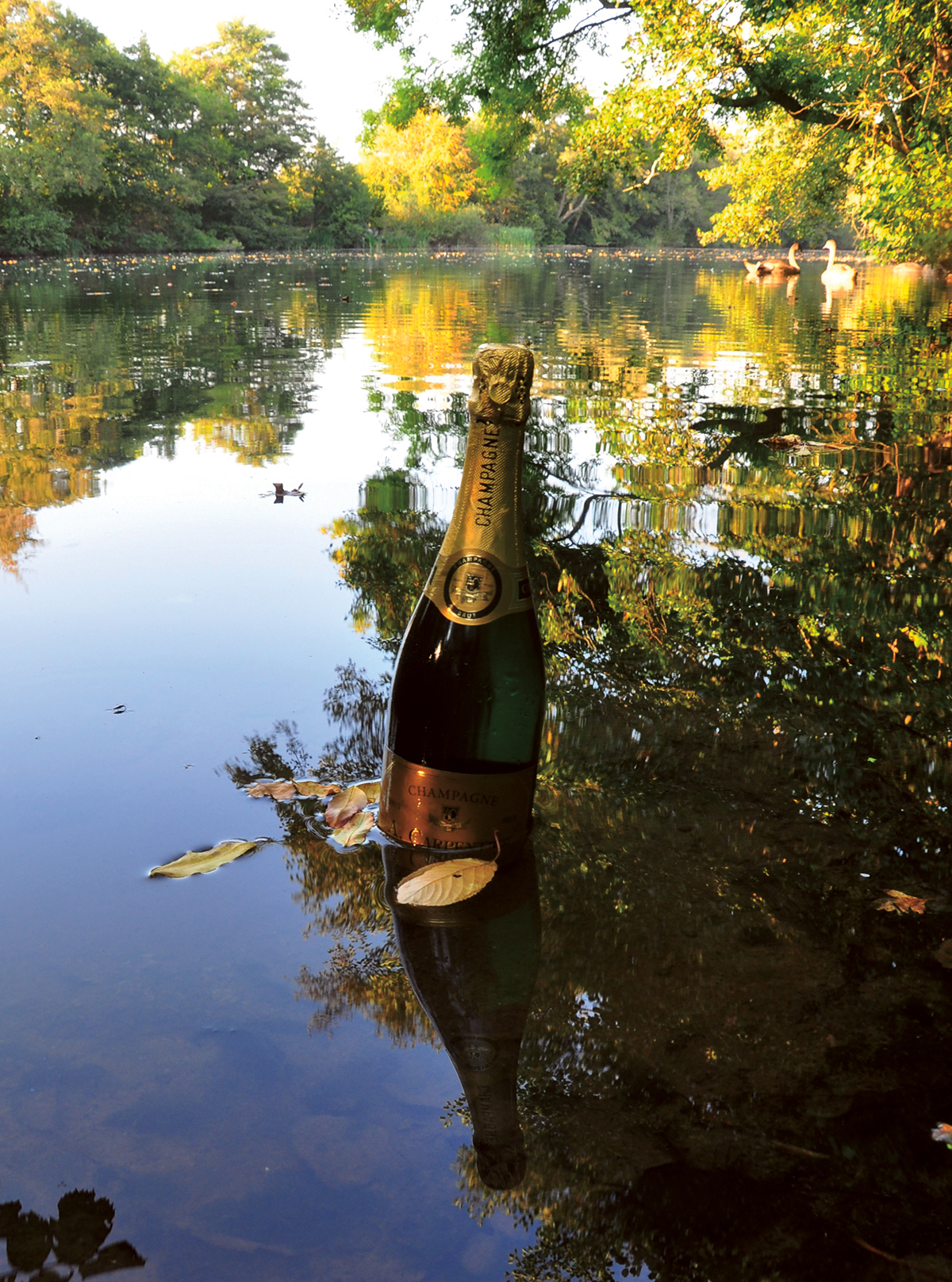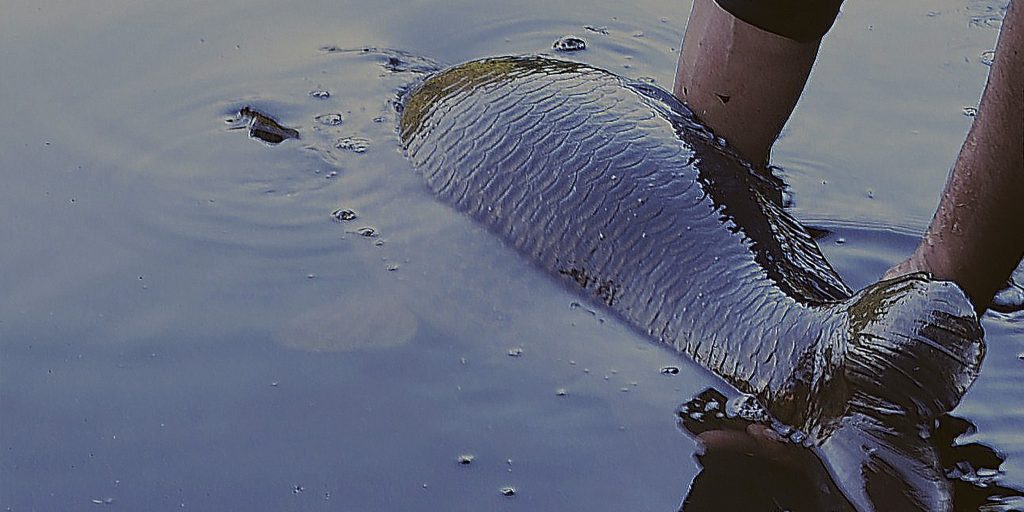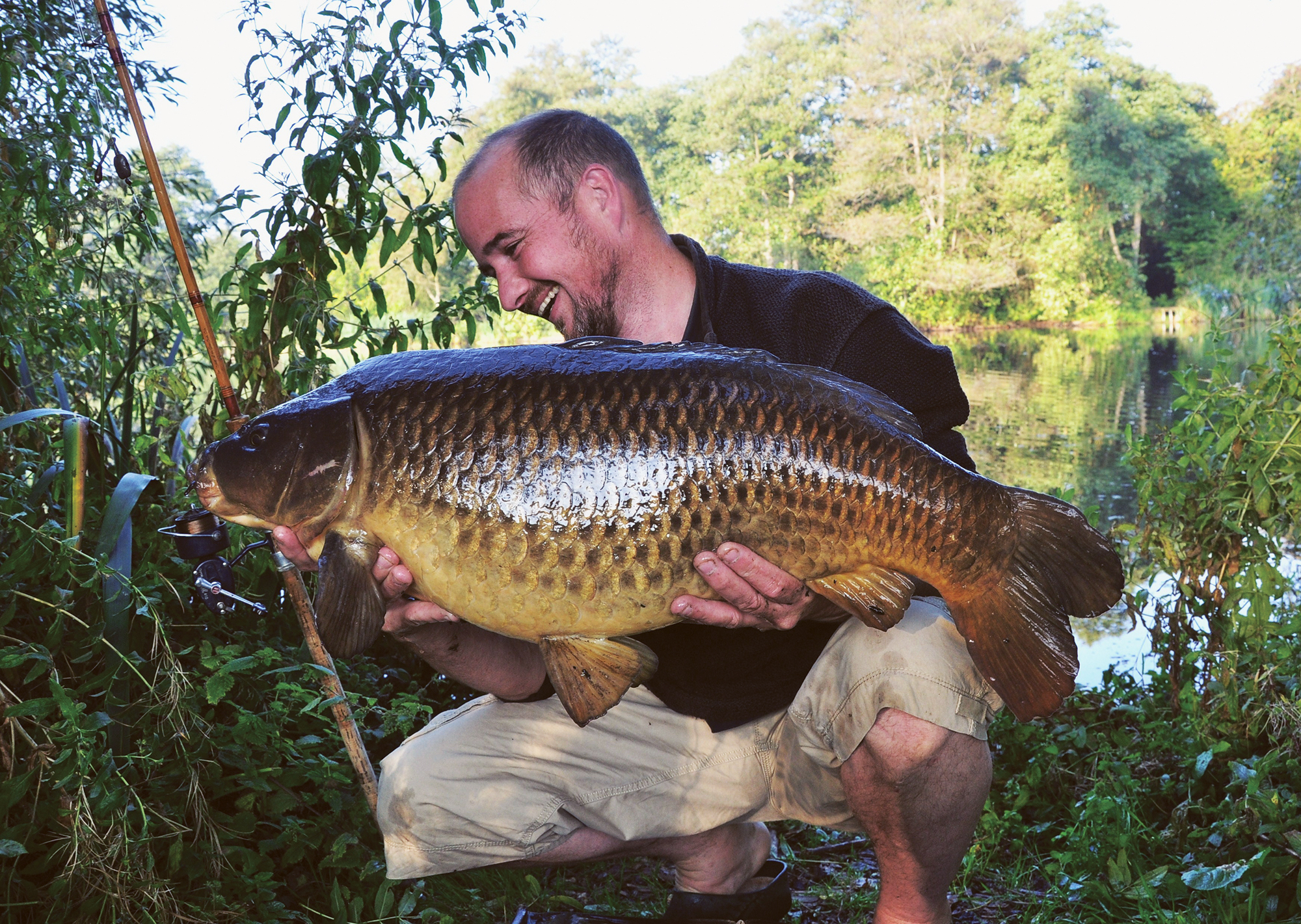Redmire. If you have any interest in carp angling whatsoever, that name will conjure magic. If your angling is rooted in traditional carp angling, that name will open a gallery in your mind from a time when carp fishing was in its infancy and everything was a glorious and exciting adventure.
I pored over the pages of Stillwater Angling as a young boy, and wondered at the tale of Richard Walker’s visit to Redmire with Pete Thomas on 13th September 1952. Even today, so many years after I was first captivated by the black and white photograph of Pete Thomas holding that magnificent Leney common, I can still recount Walker’s story of the capture of Clarissa almost word for word.
I had only just caught my first carp from the river Parrett in Somerset, when Angling Magazine dropped through the letterbox with the mind-boggling picture of Chris Yates on the cover with the new record carp from Redmire. This fish was another fantastic Leney carp, a linear mirror that he named The Bishop. My carp weighed about a pound and a half, whilst Chris’ record weighed 50lb more. Twenty years later I still have that magazine and still get a thrill whenever I read it.
These days 50lb carp are not uncommon but in 1980, Chris’ 51½lb record was simply staggering, in the same way that Walker’s ‘44’ had been in 1952. Whilst there are so many huge carp around now, Redmire is still one of the most astonishing carp lakes in the country. Three different record carp have been caught from such a small lake which only emphasises its productivity and the astonishing quality of the original Leney carp.
The death of the wonderful double row linear from Frensham (one of a diminishing number of large original Leneys that remain in this country), made me realise that the Leney era was waning and that if I was ever going to fish Redmire and experience some of the old magic for myself, I had better get on with it.
I wrote in my diary:
“I called Chris today to tell him I’m going to fish Redmire. Even though Camilla had just arrived home from London and he hadn’t seen her for ages, he still wanted to talk at length about my visit. Any lingering doubts I have about going to Redmire have now been dispelled by the tangible excitement in his voice.”
Chris even had some specific advice on where and how I should fish. “You must keep your eye on the right hand corner of the dam, where it shelves up. Right under the dam wall is the spot,” he said. “Whenever the wind pushes into that end of the pool at this time of year, the carp follow it. If the wind isn’t pushing towards the dam, you should concentrate on Bramble Island or the old pollards opposite, where the shallows start.”
The last thing I did, as the fishing drew near, was to call Chris again, to hear first-hand what a visit to Redmire in September might have in store for us. I could hear the excitement in his voice as he described how the carp visit the shallows during sunny autumn afternoons, dropping back into deeper water in the evening chill. He recounted the amazing tale of one of his most memorable autumn captures, a long common carp of 24½lb that looked like a wildie and fought for nearly two hours before Rod Hutchinson finally scooped it into the landing net. It was during this session that Rod saw the King (the great uncaught common carp that only a handful of the syndicate members ever saw) and Chris remembered thinking it was the King that he was playing throughout the epic battle.
For the first time in the 30 years we have been friends, Chris spoke about the King itself and how he saw it just once, passing through the margins beneath the willows of the ‘35’ pitch in July 1979. His voice was electric as he relived the moment. “It was just so impossibly big, it was enormous,” he said. “Was it bigger than the Bishop?” I asked. “Oh yes,” he replied, “much bigger; so much bigger that it looked unreal.”
Chris also spoke to me for the first time about the capture of the Bishop. I’d never really asked him about the record because I’d read his account so often. But now that I was going to fish Redmire myself, I needed to hear the tale afresh. Chris described his fifth cast into the shallows, how a gust of wind just blew the corn hookbait beyond the leaves of the old pollarded willow and how the great carp drifted forward and took the bait on the drop. I’ve fished for wildies with the Walker-built MkIV Avon which Chris used to catch the Bishop, and to this day I’ve never quite understood how he landed such an enormous carp on such an underpowered rod.
Chris insisted I should ring him from the lake at the end of the week to let him know if the old Redmire magic still remained. “Catch one of the old commons!” he said, “I know you will…”
When you arrive at Redmire these days, you park next to the lake. I prepared myself to be disappointed because I couldn’t believe that the Redmire of today could be anything more than a shadow of its past glories. Even so, I thought I had made a big mistake when I climbed out of the car to be confronted by the anglers’ scrap that littered the car park. There was an old barbecue rusting away under a bin bag next to a couple of cut-down plastic pub chairs, and the banks of the adjacent swims were boarded and wood chipped. It was more like a municipal park lake than the cradle of carp angling.
I remembered Muhammad Ali being interviewed by Michael Parkinson late on in his career, in the days when the punches had taken their toll, and how desperately sad it was to see the shadow of the great sportsman that remained. I feared I would experience the same painful sense of decline on seeing Redmire.
Then we saw the carp. There were three of them milling about in the gin-clear water near the overspill (just where Chris had predicted they would be), circling slowly before dipping down to feed. The sighting led us from the Oak Pitch onto the dam and in just those few short steps, the atmosphere changed completely and my fears were swept away. The dam was green with fresh grass and the view along it seemed unchanged since Dick Walker, Pat Russell and my friend Maurice Ingham had their photograph taken leaning on the dam rail in 1952.
The four of us gathered on the middle of the dam, just as they must have done, and gazed up the lake. The view was timeless and quite beautiful. Like so many anglers before me, I was immediately taken aback by the small size and the close intimacy of the lake. The first signs of autumn had painted the oak trees, and their reflections in the glass calm surface created the feeling of a pointillist painting; splashes of colour, each meaningless in their own right, combined to create the image of the perfect carp pool.
Then a very big fish appeared in the water before us and stole the moment. It swam nonchalantly towards us, maybe four feet below the surface and 10 yards out. “That’s a good fish,” said Ryan but we didn’t realise how big until it turned tail (I’m certain it saw us) and drifted back up the pool, showing the width across its shoulders. “It must be over 30,” said Martin. “A common,” added Rob. “That would do nicely!”
Any thought of the careworn appearance that greeted us in the Oaks faded away with the shadow of that common. Suddenly, I could relate to the first Redmire anglers and how they must have felt to see such carp gliding through the lake’s clear waters. For a brief moment I felt some small frisson of the excitement they must have shared, seeing such unimaginable monsters for the first time.
We enjoyed a frustrating few days fishing, watching the Redmire carp cruising in the autumn sunshine and avoiding our baited pitches as if repelled by a magnet. Eventually after a lost fish and a few missed chances, I got things right. On the last morning, after observing a carp returning repeatedly to a spot under the pollarded willows, my carefully presented bait was taken and, after an explosive fight, I slipped my net under a glorious common. I just stood in the margins, laughing like a schoolboy at the long dark carp that was cradled in the mesh.
I held that fish for a long time before I slipped her back, trying to remember every little detail, but eventually she had waited long enough and kicked into the deeper water with a strong thrust of her tail.
I retrieved a bottle of champagne from the cooling water of the overspill, popped the cork on the centre of the dam, and we toasted Redmire, almost 60 years to the day since she gave up the first of her record carp to Bob Richards on 3rd October 1951. I telephoned Chris to tell him that the magic was still strong.
The thing is though, that whilst the underlying beauty and magic of Redmire can still be found, you need to look pretty hard these days. No small pool its size can sustain that kind of angling pressure without showing the signs of wear and tear that are so evident on its banks. These days though, there are far more significant pressures than just the constant attention of anglers visiting to fish.
The land around the pool, in the upper catchment of the river Garron, is cropped for potatoes and Redmire is a sump in the landscape for the silt, nutrients and pesticides that run off the acres of bare, sandy soil. Potato cropping leaves bare soils every winter and the heavy rains of the past few years have taken their toll, leaving the pool so badly silted that you can now stand on the spot where Chris hooked his record fish. Wasp Island is now just a part of the boggy bank up in the receding shallows and even the depths off the dam wall are a fraction of what they used to be. Redmire is a parlous reflection of her past glories.
Siltation and eutrophication are just the start though. About 12 years ago, some ghost carp were stocked into the pool by accident and these have bred with the Leney carp, diluting the bloodline with their genes. If the Leney legacy of Redmire is to be restored, these ghosts and their progeny must be removed. In other words, any carp not recorded as being present in the pool for longer than say, the last 14 years, must go.
Finally, the pool has suffered from occasional otter predation, like so many waters in catchments that have strong and resurgent populations of this controversial mammal. Transient otters will make their way to stillwaters when rivers are in flood. Similarly, otters breed all year round and the cubs stay with their mothers for up to two years. Once they are driven away, it is common for them to follow the river and its tributaries upstream, to the head of the watershed in search of unoccupied territory. It is for this reason that transient juveniles are sometimes killed by cars on the top of Salisbury Plain, miles from any river. These juveniles often take up residence on any stocked pool they find and can cause devastation to fish stocks before they move on. In short, to prevent otters taking the stock, the pool must be fenced.
In 2015, Kim Richardson asked for my help with desilting the pool and my advice was that there was no point in spending money removing the accumulated silt if steps weren’t taken to prevent it happening again.
I designed a landscape scale project that would not only protect Redmire for future generations, but also transform the entire Bernithan Estate into a conservation haven that would help protect the salmon and sea trout spawning beds off the Garron and Wye downstream from the impact of the potato farming in the upper catchment.
When dealing with the effects of intensive agriculture on a fishery, you need to think on a large scale. You must understand how water and the pollutants it carries move through the landscape and act to mitigate their impact before they ever reach the fishery. Ideally, responsible farmers would stop the problems at source by only cropping appropriate soils, avoiding ploughing on slopes and creating effective buffers around our waters. Sadly the drive for profit often pushes the limits of the environment and both the incentives to protect our waters and the penalties for failing to do so are inadequate.
The Environment Agency has just published the Annual Fishery Report, which makes depressing reading. The Water Framework Directive (WFD) required the government to “aim to achieve good status (or potential) in all water bodies by 2015” (although there’s a get-out clause that means this improvement in status can be “realised through future cycles of the WFD, ending in 2027”). In 2015, the Environment Agency assessed the status of fish populations in 1,844 of the 3,924 riverine water bodies in England. Fifty-eight per cent did not even achieve ‘good’ status and of the 42% that did, only just over 14% were ‘high’.
I won’t ramble on here about the effects of Brexit and whether these WFD requirements will be met in the future, now that we will no longer be a part of the EU. I also won’t bore you with my concerns about the inadequacy of the WFD monitoring requirements and the penalties for failing to meet the required standards. There is no need; by any yardstick the report paints a gloomy enough picture of the state of our fisheries without the need for such detailed analysis.
The report presents some vague graphs to show why our fisheries are so degraded. It isn’t difficult to work out that the single biggest issue is modern farming, although this is obscured in the report by breaking farming impacts into categories such as “Mixed agricultural”, “Arable field”, “Dairy and beef field”, “Land use – arable”, “Water body bank poaching cattle/beef” and “Land drainage”. Perhaps stating simply that farming is behind the majority of the problems with of our fisheries would be too controversial? Other problems include barriers to fish movement, sewage discharges and urban development. In short, these are all problems that will take years to resolve, even if the political will and money to tackle them existed. The outlook is pretty bleak.
It is essential then, that fishery owners take matters into their own hands as much as possible and take every practical step to protect their waters. At Redmire, there is a narrow area of rough pasture around the pool that acts as a protective buffer against the agricultural run-off. I’ve designed a series of swales (dry ditches) to divert all the agricultural run-off from the surrounding fields into a series of silt traps, incorporating reed beds. These will allow the sediment to settle and strip the water of much of its nutrient loading before it enters the pool.
These features will need to be maintained and managed in rotation but they will reduce the sediment volumes entering the pool sufficiently to provide long-term stability and justify the capital expenditure needed to remove the Redmire silt. We have the 1952 depth profile of the pool and the plan is to remove the silt carefully and restore the lakebed to the way it was at that time.
I’ve always worked on the basis that if you are undertaking a major restoration programme on a water like Redmire, it is best to cover all the work that is needed at one time if possible. So, the plan is to protect the lake from further siltation and then to drain it, remove the silt present, inspect and repair the dam if needed and remove the fallen oak. Of course, that means that all the fish in the pool will need to be caught and held safely whilst this work is going on (including the precious gudgeon and eels) and that provides the perfect opportunity to sort through the stock and remove the ghost carp and their progeny.
In a reflooded and restored pool, the returning Leney stock should thrive.
Across the wider estate, we are managing the landscape to buffer the rivers downstream from the intensive agriculture taking place in the catchment above the estate. Extensive grassland management and reinstating the hedgerows shown on the old estate plans will mean that Bernithan will become a wildlife haven and provide environmental benefits far beyond the estate borders, whilst remaining productive and generating income.
Lastly, the plan is to restore the banks of Redmire and to remove the signs of wear and tear that have developed over the years. The vision we have is that if Bob Richards, Walker or BB strolled onto the dam, they would instantly recognise the pool they fished and loved. We plan to replant a weeping willow in the Willow Pitch, replace two Balsam Poplars, re-sow the banks and set the look of the pool back to the way it was 50 years ago.
Anglers visit Redmire today for nostalgic reasons and to pay homage to the cradle of carp angling and those who fished there. It is essential that the Redmire they experience matches the pool in their imagination. Unless it looks and feels as it did in the days of the Carp Catchers Club they will leave disheartened and it will become little more than a small farm pond that once held some special fish.
It won’t have escaped your notice that Bernithan Court is to be sold this year, so its future is uncertain. The wider estate management is in place and already underway, so that work is secure. I hope that the new owners (whoever they may be) will embrace the plans for Redmire’s restoration and see them through. I can’t think why a new owner would not want to restore this gem in the estate landscape, even if they are not interested in the fishing. It may be that angling at Redmire comes to an end, at least for a while, and the future of the fishery is far from certain. Time will tell and I know the current owners will do everything they can to ensure the future of the estate they love.
I must confess that I quite like the idea of those lovely Leney carp cruising gracefully through the pristine waters of a restored Redmire Pool, finally unmolested by anglers…
Photography by Mark Walsingham




